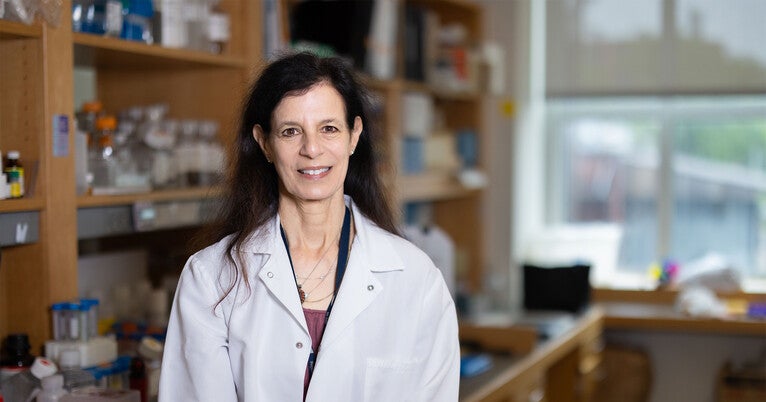Are mitochondria the key to a healthy brain?
Elizabeth Jonas first got interested in mitochondria by chance.
In 1995, she was a postdoctoral researcher at Yale, working at the Marine Biological Lab in Woods Hole, Massachusetts, where she was trying to record electrical currents inside the neurons of squids.
“Squid provide a good model for how the brain works,” said Jonas, who is now a Yale professor of neuroscience. “More specifically, in our case, they provide a good model for how the synapse, or the connection the between two neurons, works.”
Jonas eventually discovered that the recordings of electrical currents were coming from an unexpected place within the squids’ presynaptic terminal — mitochondria. These tiny organelles, which generate most of the energy in cells, are critical for the life and death of neurons and other cells.
Jonas, the Harvey and Kate Cushing Professor of Medicine and professor of neuroscience at Yale School of Medicine, is still studying mitochondria — and the role they play in memory formation and in neurodegenerative diseases like Parkinson’s disease.
In her work, she and fellow researchers have shown how a protein known as DJ-1 helps brain cells make energy by interacting directly with the key energy-making molecule, the ATP synthase — particularly in cells known to be more likely to die in Parkinson’s. Scientists know that a mature brain needs to produce energy efficiently to optimize health. That efficiency, Jonas and her colleagues found, can change depending on the interaction of molecules like DJ-1 with the ATP synthase. And when such molecules are lost or defective (as in some Parkinson’s cases), changes in efficiency fail to occur, and the brain can become subject to energy shortfalls, damage, and even death.
In a recent study, published in the journal Science Advances, Jonas explored the relationship between mitochondria, DJ-1, and Parkinson’s, finding greater losses of DJ-1 from the ATP synthase in patients with Parkinson’s. What’s more, in Parkinson’s these losses happen more often at locations farther from the cell center in the neurons that produce and release the chemical messenger dopamine. Some of these neurons (known as dopaminergic cells) are very long and extend deep into the brain to help control normal movement and other functions. As Parkinson’s gets worse, the new findings suggest, it might be difficult for these elongated neurons to repair themselves.
In an interview, Jonas discusses the link between these cellular interactions and memory, how mitochondrial dysfunction affects the brain, and what her research might reveal about managing — and even preventing — neurodegenerative diseases.
The interview has been edited for length and clarity.
What is the role of mitochondria in brain health? Is there a link between mitochondria and memory?
Elizabeth Jonas: Mitochondria do all kinds of things in the healthy brain. To get to synapses — the place where two cells meet to pass information between them — they move. If you view live mitochondria with a microscope, you can see them zipping around and stopping at the synapses where they’re needed. That’s extremely important to brain function; it turns out you can’t run synapses without moving mitochondria.
To make this move, mitochondria in the central portion of the cell [known as the soma] break off to make new mitochondria, using processes called mitochondrial fission and biogenesis. These activities are important for ongoing mitochondrial and synaptic health. Mitochondrial fusion, or the meeting of the mitochondria, is also key. Fission, fusion, and biogenesis events occur many times a day in every neuron.
We are interested in how mitochondria change rapidly during brain functioning. How plastic are mitochondria? Are they changing all the time, and what’s the time course of those changes? If you look inside the mitochondria and take a picture, do you see changes? The answer is yes, and those changes can occur over seconds to minutes.
How does mitochondrial dysfunction or damage contribute to brain disorders, whether psychiatric illnesses or neurodegenerative diseases?
Jonas: Mitochondria contribute to these disorders in many ways. Arguably the most important is that mitochondria generate energy in the form of adenosine triphosphate [ATP], the main energy source in living cells. When mitochondria are damaged, such as in brain degenerative disorders, their mobility, their ability to produce energy, and their regulation of several cellular processes including cell repair and waste disposal, become dysfunctional, placing cells at risk.
Neurons cannot function without mitochondria. Loss of mitochondrial functions may occur in developmental disorders as well as degenerative disorders. Equally important to energy production is the role that mitochondria play in cell growth and repair. If you can’t repair neurons that have experienced damage, then that’s a problem.
Mitochondria contribute to growth and repair by making the amino acids and lipids that are the building blocks for cellular molecules. If cells can’t repair broken proteins and lipids, the brain cannot function. But on the other side, if you cannot stop making proteins, for example, that’s also a huge problem because then you get build-up of extra proteins which leads to degradation overload known as “proteostasis dysfunction.”
Specific to neurons and synapses, the minute-by-minute electrical activity and communication between neurons — known as action potential firing and neurotransmitter release — are regulated by mitochondria. To perform these activities properly, neurons rely on mitochondria to take up ions like calcium to make ATP and to manage the special proteins and lipids required for these functions.
How might studying the role of mitochondria in brain disorders improve treatment for people who develop them?
Jonas: We have found an ion channel [a hole in the cell membrane that allows the passage of electrically charged particles called ions] that is the source of many of the problems, including the loss of energy efficiency and dysfunction in cell repair. The channel is a leak in the mitochondria known as the ATP synthase c-subunit ring [ACLC].
Channels are good drug targets because opening and closing them can drastically change electrical activity of organelles and cells. With ACLC, closing it stops the leakage in mitochondria, making them work better again. This way, we can adjust ACLC channel activity to control how much energy is produced and how quickly proteins and fats are made in the neurons of people with neurodegenerative diseases. We now have some promising compounds that can stop the leak.
We’re also testing the compounds to try to understand the different settings in which these may be helpful and to determine the appropriate timing of their use. Where and during what stage of development or degeneration will it be most useful for patients to take the compounds? Will specific areas of the brain need to be targeted? Will other organs in the body benefit from these treatments or from the prevention of damage that these compounds may provide? Will there be negative consequences from long term treatment with these compounds?
Moving forward, what else do you hope to explore in terms of mitochondria and the brain?
Jonas: We want to know the role mitochondria play in memory formation, in mood disorders, and in motor function not only in the brain but also in other organs of the body. How do they play a role in aging? In muscle and heart strength? In liver and kidney function and disease? How can we use what we know about mitochondria to prevent neurodegeneration? How can we improve neurodevelopment so that people with neurodevelopmental disorders can have normal function as they grow up? We have a lot of work to do! Mitochondria are not just the “powerhouses” of cells but have many other jobs that we and other scientists are exploring. There is more to be discovered!













